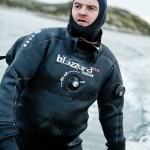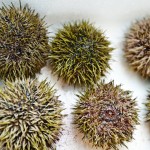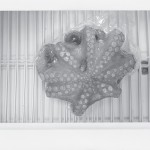Roderick Sloan is the man supplying Noma and other top eateries with its sea urchins,he lives in a tiny village way up north and dives into insanely cold water. Roderick is a 42 year old Scotsman that moved to Norway 15 years ago after falling in love. 5 years laterhe and his lovely wife moved to arctic Norway to begin fishing sea urchins. Rod is considered a young man in his village of 80 people. Nordskot, in the municipality of Steigen, is surrounded by mountains on one side and a chain of islands to west that protects them from the huge sea rolling in from the fierce North Atlantic in the winter. They have an abundance of wildlife all around them. Anything from moose, reindeer and otter to sea eagles and grouse. For Rod however, the real action is at sea, where he spend a lot of time. On an average day he sees sea eagles, otters, seals and obviously a lot of fish when he is diving. Seeing Orcas on the way to work is must be amazing!
We asked Roddie a few questions about his life, work and passion. Read on to find out what a passionate guy and a pint stout can come up with…
MG: Why do you do what you do? I’m sure a lot of people ask this… but then again it’s not your average 9 to 5 job.
RS: I simply love what I do and the freedom it gives me.
MG: Why sea urchins?
RS: It started as a crazy idea over a pint of Guinness and then became a reality.
MG: What else do you find or catch?
RS: Sea urchins are my main fishery but we do other shellfish, like the mahogany clams and the softshell clams. But I’m still not fully comfortable with the fishing of other species, so they are still only in small numbers. I also do a lot of experimental fishing for strange things like starfish and sea cucumbers. I have just finished a small test fishery with Ben Reade of the Nordic Food Lab so you should be able to read the results soon.
MG: Can you describe your usual workday?Do you have some company or do you dive on your own?
RS: I think like all small business people, I can’t say I have a usual work day. There are always so many things to deal with and they all require different thinking, but an average fishing day might go like this. Start at 8 in the morning and go out to the fishing site. Dive for the day and return home at about 4. Some dinner, emails, and then bed 9:00pm. I then get up at 2 in the morning and go out to sea. I pick up the nets of sea urchins that we’d fished, bring them back to shore and then pack them ready for the 8am boat to the town where the airport is. I do really want a helicopter… I spendthe rest of the day stressing about snowstorms and planes and possible delays, hassling my logistics guys to hell and back. Fortunately they are quite nice to me.
MG: How cold is it really? We got to try the ice but how do you explain it when someone asks?
Note: Rod was a speaker at the MAD Foodcamp 2012 in Copenhagen. He made us all kiss small pucks of frozen sea water to get a feeling of his environment. The few brave that could hold on got numb and started to blabber rather than speak.
RS: The thing people don’t understand if they’re not from here is that in winter, the water is actually not the coldest place. The sea stays at a balmy +4 to -2, any colder and it is ice. The air temperature these days, midwinter, can be anywhere from zero to minus 13 or so which we’ve had in the last couple of weeks. Add the wind chill factor and if there is a light breeze I can be out in a boat in an effective minus 25. Now that’s cold.
MG: What’s the toughest part of your job? Other than the cold…
First of all, the cold is not a problem, it’s just there. The biggest challenge?Quality.Quality chain, the way from the sea to the table. There are a lot of links in the chain and one single mistake can break the whole system.
MG: Do you use any special equipment?
RS: Yes and no. There are no tool shops that specialize in sea urchins so I whatever I need I have to make it, or adapt from something else. My diving gear is all ice qualified, having said that, though, we just had a visitor who came straight from having dived in the Antarctic – and his gear failed. We read a lot and we learn from our mistakes, after 10 years plus, I have a fair idea what works and not.
MG: I’ve read that you can estimate your daily catch by observing nature. Is it true and if so how?
RS: That is not really true, but we spend about a month a year surveying, qualifying the fields. So we know where to go at what wind direction, waveheight etc. Even so we still get it wrong sometimes, or theweather beats us to the ground.
MG: What is your average catch per day? If you don’t mind me asking… How much do you sell it for? People must think you’re making a fortune.
RS: Then they see my boat, and realize I’m not making a fortune at all. I could take a job tomorrow and make more money, but the real value in this is not the cash. I love the physical aspects of my job, except when I am thawing my hands out for hours after a day at sea, but the main reward is the response my product gets. Watching people eat my sea urchins – that never gets old. Plus it has brought me a lot of amazing contacts, experiences and knowledge that I would never have had otherwise. Oh, and the price per kilo of round sea urchin is about *cough* these days. Do you want to buy some?
MG: Is there any governmental body that supports or funds your job?
RS: Nah… Having said that, I have been paid for giving speeches, writing reports and statements, but that’s part of the job I guess. Perhaps that will change in the future. Resources of the sea are very much under-valued I think.
MG: How did you meet Rene & Co? How many locations or chefs buy your spiny balls?
I didn’t meet him, he phoned me. I had just decided to stop working with the urchins and this mad Dane phoned me. I tried my best to persuade him there would be too many problems to be worth it but you know,he is a powerful guy. Then I met him and he convinced me instead. He came to sea with me in February wearing trainers and he didn’t complain for five hours. That’s dedication for you.
MG: Other than Rene, have other chefs joined you? Do they have the balls for it?
RS: Oh, you mean in the north? We did a workshop this year, the F12, and are planning another one in 2014. The idea is to take not the chefs but the sous-chefs, and teach them about what we are doing; sea life – get a few journalists together, bring in some controversial topics – let them work it out. The sea and its resources, there is a limited amount of knowledge about it, and how to use them. Norwegians have fantastic fisheries policies that really work, but are condemned for their whaling, which to me is wrong.
MG: Do you notice any decrease in the sea urchin population as a result of the climate change?
RS: No, but I have read some scientific reports that claim I should see some change. I really don’t think we know the population cycles of the sea urchins well enough to understand them; I have my own theories but… Let’s just say if a mad scientist comes along and wants to compare notes, I am ready.
MG: Considering the difficulty of harvesting the sea urchins up north, are they that much better than urchins from other areas? Have you tried a lot from other places??
RS: I have tried California, East coast America, Ireland, Mediterranean and I have got to say that ours are pretty darned good. Irish may have a nice taste, but they are not as big, roe wise, and they are overfished to hell. I really think the Norwegian Green isa pretty good sea urchin, especially when picked with care, but I am just a stupid fisherman.











